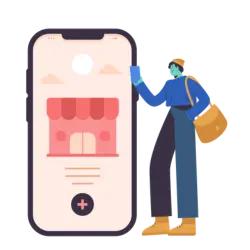TABLE OF CONTENTS

Selling on Instagram has become an increasingly popular avenue for businesses in the world of online commerce. In the 2nd quarter of 2022, online sales accounted for more than 14% of total retail sales in the United States — representing a more than 100% increase in market share since 2014.[1]US Census Bureau News. “Quarterly Retail E-Commerce Sales“. Accessed on October 6, 2023.
While many businesses assume starting an online business refers to selling on a website, it’s now easy to open up shop via social media platforms. Instagram offers a full-scale sales platform to merchants, allowing them to sell directly to customers via their Instagram profile. This direct sales platform streamlines the process of selling to customers.
If you want to benefit from selling on Instagram, there’s never been a better time to start. Instagram makes its selling platform accessible for businesses of any size, so there’s no reason you can’t benefit from listing your products on its site.
This guide offers a step-by-step guide for selling products on Instagram. Additionally, we’ll explore Instagram fees, how selling on Instagram benefits your business, rules for selling on Instagram, and other related topics. If your business is ready to take advantage of one of the world’s most powerful social media channels, read ahead!
How to Sell Products on Instagram in 10 Easy Steps
It’s not challenging to sell products on Instagram if you follow the correct steps. Getting started on the right foot is essential if you want to avoid wasting time. Let’s explore the Instagram selling process below:
1. Find your niche
If you are new to selling products, you need to find your niche. Instagram offers an excellent platform for building sales, but you should start by finding a product you can market to potential customers.
If you already have a business, you can skip this step. Many established businesses sell their products and services directly via Instagram, so you won’t need to alter your products to suit a social media platform. Instagram will simply operate as another channel for generating business sales!
What to sell on Instagram
If you are new to selling products, you must choose the best items to attract attention and generate revenue. Spend time researching product ideas that are popular with consumers and identify which markets have space for your new business to make a name for itself. You can look to your close group of family and friends or reach out to the target demographic you want to market to.
Also, some businesses make the mistake of choosing too many products. If you operate too broadly, it can be challenging to market your products effectively. On top of that, when customers are presented with too many options, it can be overwhelming. This can lead to longer purchasing timelines. Focusing on a particular product line or niche will help you invest the time and resources necessary to develop successful product launches.
Some industries that are popular with Instagram sellers include:
- Health & fitness equipment
- Supplements
- Apparel
- Personalized gifts
- Packaged travel deals
- Workout programs
2. Create your Instagram business account
Once you establish which products you want to sell, it’s time to start building your profile on Instagram. For businesses wanting to create a commercial space on Instagram, there are specific “Instagram business” accounts. Fortunately, Instagram business profiles are free, and the signup process only takes a few minutes.
Once you have an Instagram business account, it’s easy to access its business features, such as ads, scheduled posts, insights, and more. While some of the additional social media marketing features, such as sponsored posts, cost money, you won’t need to worry about paying monthly fees to access the core Instagram business dashboard.
3. Set up an Instagram shop
Now it’s time to set up an Instagram shop. Fortunately, this process only takes a few minutes, and it makes selling products on Instagram much more streamlined. Head to your Instagram business profile’s “Settings” tab and select “Creator.” Next, select “Set up Instagram Shopping.” Now, you can connect a catalog, enter your website URL (for verification), choose a checkout option, select sales channels, add products, and explore a preview of your new online shop.
This shop serves as a central hub for all your Instagram sales activities. There’s an internal dashboard for managing your shop, customizing features, and more. As your shop grows, your business can continue to make changes and improvements.
If you want to accept payments directly via Instagram, make sure to sign up for Instagram Checkout during this stage. This service allows your customers to checkout within the Instagram app. However, it’s only available for businesses located in the United States.
Define your branding
Establishing and maintaining your business’s branding is critical. Whether you have existing logos, color palettes, and other branding components in place or you’re starting from scratch, the key is to consistently communicate a unified message. Having your Instagram posts align with your branding guidelines is equally vital.
Link to your eCommerce site in your bio
Ensuring that your eCommerce website is easily discoverable by your customers should always be a priority. Utilize your Instagram bio as a direct link to your online store. While some businesses may include additional information in their bios, it’s considered a best practice to prominently feature your website URL.
4. Set up Instagram shopping
Just because you have an Instagram shop doesn’t mean customers are ready to shop on your profile. Now you must upload products, photos, pricing, and other core details to begin selling products on Instagram. Doing so immediately after you set up your shop will ensure your business is ready to sell products and services as soon as you begin producing content.
While Instagram shopping allows you to create a central store for users to browse, it’s also helpful to create Instagram shopping posts. These posts integrate products, photos, and prices into traditional Instagram posts, making it simple for customers to purchase products. These hybrid shopping tools mean customers don’t have to navigate your store to purchase products seen in your posts.
5. Create engaging content
Once you have products available for purchase, it’s time to begin creating engaging content. Whether it’s Instagram posts, stories, reels, or any other pieces of content, your aim should be to garner attention from potential customers. Let’s explore some engaging post examples below:
- Photos of Products in Use: High-quality product photos or photos with products in use can help build awareness about what your business sells on Instagram. You can also use shopping posts to make the checkout process simpler.
- Giveaway Posts: Sweepstakes and giveaways are a surefire way to promote your brand on Instagram. A quick browse of other businesses selling on Instagram will show you how popular giveaways are with users!
- Posts with Details About Celebrity/Influencer Partnerships: Using celebrities, influencers, and other well-known figures can be an excellent way to grab attention. However, this won’t be possible on a small budget.
- Quizzes and Polls: Quizzes, polls, and other interactive posts can foster engagement from followers wanting to interact with your brand.
Repurpose user-generated content
If Instagram users create content about your brand or products, repurposing it yields excellent benefits for your business. Repurposed user-generated content increases organic social media reach, ensures your business generates creative posts, and offers a range of other benefits.
Some examples of repurposed user-generated content include screen record clips posted by Instagram followers using your products and including them in ads or commercials. Or taking screenshots of positive customer reviews and including them in ads or commercials. However, make sure to gain permission from the user before you use their work or content. Not doing so may create content ownership issues and cast your brand in a negative light with other social media users.
6. Use relevant hashtags
Don’t underestimate the power of using hashtags to boost your content. Research suggests posts with hashtags often receive more than 12% extra engagement.[2]Brand24 Global Inc. “Instagram Hashtag Analytics: How to Track Performance“. Accessed on October 6, 2023. This is because hashtags act as keywords, making it easier for social media users to find products and posts. If you create hashtags using keywords relevant to your target audience, your business may see a surge in engagement and Instagram traffic.
7. Utilize Instagram reels & stories
Another avenue for creating engaging content involves Instagram reels and stories. Reels are short clips, similar to what users find on TikTok, which allow your business to reveal its creative flare. Likewise, stories are short clips or graphics that are posted to your account for 24 hours—they’re an excellent tool for keeping customers and followers updated on your latest offerings, products, or events.
8. Work with influencers
Influencers are individuals with “influence” in a particular niche. For example, someone with a fishing-based Instagram account with millions of followers would likely be considered an influencer in the fishing world. Influencers have tremendous sway in their niches because they start trends, influence preferences, and more.
Hiring influencers to produce content, post products, and promote your brand can establish your business in your niche. Estimations value the Instagram influencer market size at over $13b—there’s no doubt this promotion channel results in strong outcomes for many businesses.[3]Statista. “Influencer marketing worldwide – statistics & facts“. Accessed on October 6, 2023.
However, as with any marketing strategy, it’s important to tread carefully with influencer marketing. Always analyze influencer reach, create legal agreements, and clarify what’s expected from your influencer’s promotional relationship. Not doing so can lead to disappointing results.
9. Consider live shopping
While TV shopping no longer has the same popularity as in the 1990s and early 2000s, Instagram offers an excellent alternative for businesses wanting to showcase products. With Instagram Live Shopping, you can create live videos displaying your products, discussing their features, and more. By connecting the product links to the live video, Instagram Live Shopping makes it simple for customers to select products in the video and purchase them immediately.
10. Build Instagram advertisement campaigns
Last but not least, it’s time to build an Instagram advertisement campaign. While Instagram remains an excellent platform for building an organic audience, the social media giant continues to move further toward its ad-based business model. This means if you want the best possible exposure to potential customers, you need to pay.
Fortunately, Instagram allows its business users to access a world-class advertising platform. Instagram ads make it simple to pinpoint consumers based on attributes and interests, meaning your business can manage ad campaigns targeting customers likely to be interested in your products or services.
How Selling on Instagram Benefits Your Business
It’s time to decide: Is selling on Instagram the best option for your business? Let’s explore the advantages of selling products and services on the platform:

Exposure
To start, Instagram provides excellent exposure for your business—it hosts more than 1.2 billion monthly users.[4]Statista. “Number of Instagram users worldwide from 2020 to 2025“. Accessed on October 6, 2023. With such a large pool of users to access, Instagram makes it easy to connect with consumers across the globe. Your business can use tags, ads, and other methods to attract attention to your products and services.

Access to influencers
Next, Instagram plays home to some of the most powerful influencers in the world. Your business can build brand recognition by hiring influencers to market your products, tag your company, and engage with your audience. Likewise, as Instagram has a direct sales platform, the sales pipeline between consumers, influencers, and your business is seamless.

Data-driven ads
Unlike traditional advertising, such as billboards and radio, Instagram ads allow merchants to segment the market and direct ads toward individuals with specific interests, backgrounds, and more. If you know what types of customers typically like your products and services, Instagram will help you target relevant consumers at scale.

A purpose-built platform for selling
As discussed in the step-by-step selling section of this guide, Instagram is a purpose-built platform for selling products. The entire sales process is streamlined to help your business convert prospective customers quickly. Once you master the selling process, you’ll benefit from a range of automated tools.

Authentic customer interactions
Next, Instagram offers its users and business partners a range of avenues for communicating and connecting. Whether it’s posting photos of your products in use, starting an Instagram Live to showcase your services, or speaking with customers over the direct messaging platform, Instagram makes it easy to interact with your followers.

Doesn’t restrict you from other platforms
Lastly, no Instagram contracts restrict your business from using other social media companies or online sales platforms. If you choose to use Instagram to sell products, it can be part of an omnichannel sales approach incorporating a broad range of online sales options. Some of the biggest brands in the world use other social platforms to market.
Rules to Sell on Instagram
If you want to sell on Instagram and avoid account termination, follow five simple rules:
- Comply with Policies: Your business must comply with Instagram’s policies, including Commercial Terms, Community Standards, and Terms of Service.
- Be Operated in a Geographic Location that Supports Instagram Selling: Instagram selling is widely available worldwide. However, there are some locations ineligible for this service. Make sure your business remains located within a supported area if you plan to sell on Instagram.
- Exhibit Trustworthiness: Make sure to build a trustworthy reputation on Instagram. Some methods for exhibiting trustworthiness include building a follower base, interacting with followers, and being honest with customers.
- Demonstrate You Represent Your Company and Domain: Your Instagram must represent the website or store where you sell your products. Likewise, the products must be available for direct purchase from your business’s website.
- Always Follow Best Practices: Lastly, make sure your business follows best practices and provides correct information to customers. Never misrepresent products or services.
Instagram Shop Fees: How Much Does it Cost to Sell on Instagram?
If you plan on selling on Instagram, you might be wondering: How much do I need to pay to Instagram per transaction? If you don’t process payments via Instagram, you won’t pay anything to sell your items. For example, you won’t pay a commission if a customer finds a product on your Instagram profile, clicks a link, and purchases the product on your website. You will only pay your traditional payment processing fees from your payment processor, not Instagram.
However, if you operate a US-based business and you want to use Instagram Checkout to process payments within the app, you must pay the following fees:
- For products over $8: a 5% fee
- For products $8 or less: a $0.40 fee
If you already sell products elsewhere online, you can understand that this is a steep processing fee. However, as the Instagram Checkout service helps streamline the process of selling items and services online, it still benefits several businesses.
Selling Products on Instagram: Closing Thoughts
Understanding how to sell products on Instagram can transform your business and help you access millions of online shoppers. This guide’s step-by-step process will help your business approach the initial sales processes correctly. While there’s no doubt Instagram offers powerful selling tools and excellent advertisements, it’s also essential to build a website and other online sales channels. Make sure to choose an affordable eCommerce merchant service provider if you want stronger and more personalized payment options for your business. A merchant service provider can facilitate secure payment processing, streamline transaction management, and enhance your customer’s shopping experience, ultimately contributing to your business’s long-term success in the online marketplace.
Level up your online business!
Accepting payments has never been easier.
Merchant Account today
Simple
Instagram Seller FAQs
Do I need a business license to sell on Instagram?
No. You don’t need a business license to begin selling products and services on Instagram as long as you abide by Instagram’s policies and rules. However, obtaining a business license may be a legal requirement for your business, so don’t overlook the need for correct licenses and permits if you want to start a new company.
How can I accept payments on Instagram?
While many businesses link their Instagram shops to their eCommerce websites and process payments externally, Instagram now has a platform for accepting payments directly via the app. Instagram Checkout allows US business owners to sell products within the app, streamlining the process of selling products directly to consumers.
Does Instagram take a percentage of sales?
In most cases, it’s completely free to sell products on Instagram, meaning you will only need to pay your payment processor’s fees to access the benefits of this service. However, the new Instagram Checkout platform, which allows customers to buy products without leaving the Instagram app, does charge a 5% fee for purchases or 40 cents for purchases valued at $8 or less. Likewise, you will need to pay for Instagram ads, so the cost of ad campaigns should be factored into your overall sales costs.
Is selling on Instagram safe?
While Instagram provides a secure platform for selling goods and services, your business must remain vigilant against scammers. As with any online sales platform, Instagram suffers from fraudsters looking to take money from merchants. Always use strong internal business practices to ensure your business avoids chargebacks and fraud-related issues.
What countries is Instagram shopping available in?
Fortunately, Instagram shopping is available in a broad range of countries, meaning your business has access to a large number of consumers if you choose to sell products and services via this social media channel. Take a look below for the current list of countries compatible with Instagram shopping:
| North America | Canada, United States |
| Latin America | Argentina, Belize, Bolivia, Brazil, Chile, Colombia, Costa Rica, Dominican Republic, Ecuador, El Salvador, French Guyana, Guadeloupe, Guatemala, Guyana, Martinique, Mexico, Panama, Paraguay, Puerto Rico, Peru, Suriname, Uruguay, Venezuela |
| Europe, the Middle East, and Africa | Algeria, Armenia, Austria, Belgium, Bulgaria, Cameroon, Côte d’Ivoire, Croatia, Cyprus, Czech Republic, Denmark, Egypt, Estonia, Finland, France, Georgia, Germany, Ghana, Greece, Hungary, Kenya, Ireland, Israel, Italy, Latvia, Lebanon, Lithuania, Luxembourg, Malta, Mayotte, Moldova, Morocco, Netherlands, Norway, Poland, Portugal, Romania, Reunion, Russia, Saudi Arabia, Serbia, Slovakia, Slovenia, Spain, South Africa, Sweden, Switzerland, Tunisia, Turkey, United Arab Emirates, United Kingdom, Ukraine (Only some regions due to US sanctions on Russia) |
| Asia-Pacific | Australia, Bangladesh, Hong Kong, Indonesia, Japan, Kazakhstan, Korea, Laos, Philippines, Malaysia, Mongolia, Myanmar, Nepal, New Zealand, Singapore, Sri Lanka, Taiwan, Thailand |






